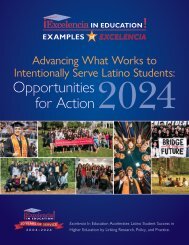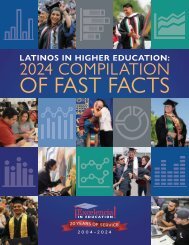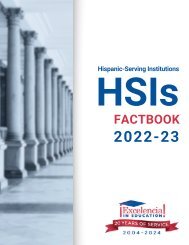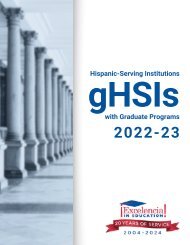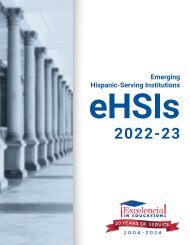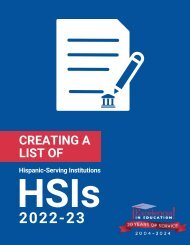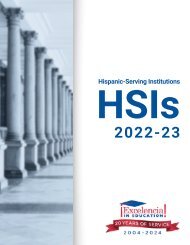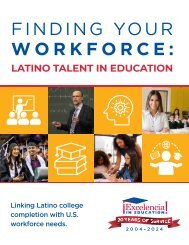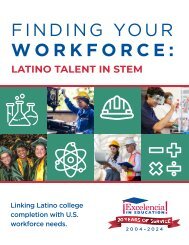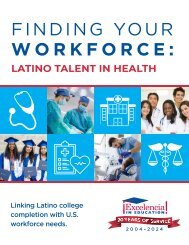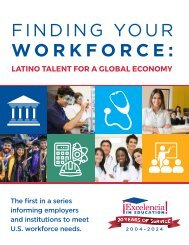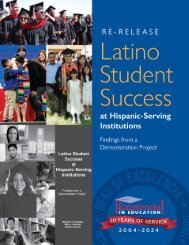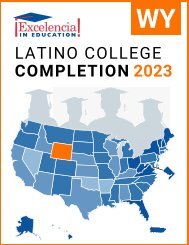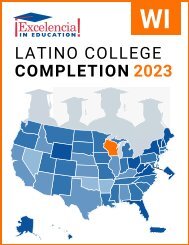Latino College Completion 2023: Maryland
Create successful ePaper yourself
Turn your PDF publications into a flip-book with our unique Google optimized e-Paper software.
MD
LATINO COLLEGE COMPLETION:<br />
MARYLAND –<strong>2023</strong><br />
For the U.S. to regain the top ranking in the world for college degree<br />
attainment, <strong>Latino</strong>s will need to earn 6.2 million degrees by 2030. 1<br />
FAST FACTS<br />
STATE RANKING:<br />
<strong>Maryland</strong> had the 17th largest<br />
<strong>Latino</strong> population in the U.S.<br />
K-12 POPULATION:<br />
In <strong>Maryland</strong>, 16% of the K-12<br />
population was <strong>Latino</strong>. 2<br />
POPULATION:<br />
In <strong>Maryland</strong>, 11% of the population<br />
was <strong>Latino</strong>. 2<br />
MEDIAN AGE:<br />
The median age<br />
of Hispanics in<br />
<strong>Maryland</strong> was 29,<br />
compared to 44<br />
for White non-<br />
Hispanics. 2<br />
29<br />
Hispanics<br />
44<br />
White<br />
non-Hispanics<br />
ENROLLMENT:<br />
In <strong>Maryland</strong>, 19% of Hispanics<br />
(ages 18 to 34) were enrolled in<br />
higher education, compared to 24%<br />
of White non-Hispanics. 2<br />
DEGREE ATTAINMENT:<br />
In <strong>Maryland</strong>, 29% of Hispanic<br />
adults (25 and older) had earned an<br />
associate degree or higher, compared to<br />
56% of White non-Hispanic adults. 2<br />
Hispanic Adults = 2.9 of 10<br />
To reach the degree attainment goal by 2030, the U.S. can: close<br />
the degree completion gap by accelerating <strong>Latino</strong> completion while<br />
increasing for all students and scale up programs and initiatives that<br />
work for <strong>Latino</strong>, and all, students. The following demographics,<br />
institutional data, and practices inform <strong>Latino</strong> degree attainment.<br />
ENROLLING: Top 5 Institutions (Hispanic Undergraduates) in <strong>Maryland</strong>, 2021-22<br />
Institution<br />
Sector<br />
Grand<br />
Total<br />
NOTE: We use the terms <strong>Latino</strong> and Hispanic interchangeably in this factsheet.<br />
Hispanic<br />
Total<br />
Source: Excelencia in Education analysis using U.S. Department of Education, National Center for<br />
Education Statistics (NCES), Integrated Postsecondary Education Data System (IPEDS), 2021 Fall<br />
Enrollment, Graduation Rates Survey and Institutional Characteristics Survey.<br />
%<br />
Hispanic<br />
1 University of <strong>Maryland</strong> Global Campus Public, 4-year 42,992 6,770 16%<br />
2 Montgomery <strong>College</strong> Public, 2-year 13,650 3,746 27%<br />
3 University of <strong>Maryland</strong>-<strong>College</strong> Park Public, 4-year 30,368 3,097 10%<br />
4 Towson University Public, 4-year 17,817 1,745 10%<br />
5 Prince George's Community <strong>College</strong> Public, 2-year 8,397 1,501 18%<br />
ASSOCIATE DEGREES: Top 5 Institutions Awarding to Hispanics in <strong>Maryland</strong>, 2020-21<br />
Institution<br />
Sector<br />
Grand<br />
Total<br />
Hispanic<br />
Total<br />
%<br />
Hispanic<br />
1 Montgomery <strong>College</strong> Public, 2-year 2,874 709 25%<br />
2 University of <strong>Maryland</strong> Global Campus Public, 4-year 2,510 543 22%<br />
3 Prince George's Community <strong>College</strong> Public, 2-year 1,203 169 14%<br />
4 Anne Arundel Community <strong>College</strong> Public, 2-year 1,712 145 8%<br />
5 Frederick Community <strong>College</strong> Public, 2-year 886 126 14%<br />
BACHELOR DEGREES: Top 5 Institutions Awarding to Hispanics in <strong>Maryland</strong>, 2020-21<br />
Institution<br />
Sector<br />
Grand<br />
Total<br />
Hispanic<br />
Total<br />
%<br />
Hispanic<br />
1 University of <strong>Maryland</strong> Global Campus Public, 4-year 7,637 928 12%<br />
2 University of <strong>Maryland</strong>-<strong>College</strong> Park Public, 4-year 7,573 768 10%<br />
3 Towson University Public, 4-year 4,620 377 8%<br />
4 University of <strong>Maryland</strong>-Baltimore County Public, 4-year 2,548 234 9%<br />
Private not-forprofit,<br />
4-year<br />
5 Johns Hopkins University<br />
1,425 202 14%<br />
White Adults = 5.6 of 10<br />
1 Projections to 2030: Excelencia in Education. (2020). Ensuring America’s Future: Benchmarking <strong>Latino</strong><br />
<strong>College</strong> <strong>Completion</strong> to 2030. Excelencia in Education. Washington, D.C.<br />
2 U.S. Census Bureau, 2021 American Community Survey 1-Year Estimates
<strong>Maryland</strong> Gap in Degree <strong>Completion</strong><br />
Closing the degree completion gap can be tracked<br />
by the 4 measures shown below. Alone, none<br />
of these measures capture the entire “story” of<br />
degree completion. However, in combination,<br />
they provide a useful picture of the gap in degree<br />
attainment between Hispanic and White non-<br />
Hispanic cohorts in a single year.<br />
Graduation Rate — Total percentage of students<br />
who graduated within 150% of normal time for<br />
first-time, full-time freshmen. This incorporates<br />
students that graduated in 3 years at two-year<br />
institutions, or in 6 years at four-year institutions.<br />
Transferred to Another Institution —<br />
Percentage of students that transferred to another<br />
institution and did not complete a degree.<br />
Still Enrolled — Percentage of students that are<br />
still enrolled at the point of 150% normal time to<br />
completion.<br />
No Longer Enrolled — Percentage of students<br />
that are no longer enrolled at the point of 150%<br />
normal time to completion.<br />
At two-year institutions, Hispanics’<br />
graduation rate was 3%-points<br />
lower than that of their White<br />
non-Hispanic peers in <strong>Maryland</strong>.<br />
TWO-YEAR INSTITUTIONS<br />
35%<br />
13%<br />
20%<br />
33%<br />
WHITE<br />
-3%<br />
39%<br />
18%<br />
14%<br />
30%<br />
HISPANIC<br />
DEGREE OUTCOMES<br />
■ No Longer Enrolled<br />
■ Still Enrolled<br />
■ Transferred to<br />
Another Institution<br />
■ Graduation Rate<br />
*Percentages may not add up to 100% due to rounding.<br />
At four-year institutions, Hispanics’<br />
graduation rate was 4%-points<br />
lower than that of their White<br />
non-Hispanic peers in <strong>Maryland</strong>.<br />
FOUR-YEAR INSTITUTIONS<br />
1%<br />
10% 12%<br />
13%<br />
2%<br />
14%<br />
76%<br />
WHITE<br />
-4%<br />
72%<br />
HISPANIC<br />
NOTE: Outcomes shown are for students at two-year institutions who started in Fall 2018, and<br />
for students at four-year institutions who started in Fall 2015.<br />
Source: Excelencia in Education analysis using the U.S. Department of Education, National<br />
Center for Education Statistics (NCES), Integrated Postsecondary Education Data System, 2021<br />
Graduation Rates Survey and the Institutional Characteristics Survey.<br />
Examples of What Works for <strong>Latino</strong> Students<br />
There are institutions showing success in enrolling, retaining, and graduating <strong>Latino</strong> students. The following are examples of<br />
programs across the country with evidence of effectiveness in serving <strong>Latino</strong> students nominated for Examples of Excelencia.<br />
Ambiciones provides pathways to college completion for <strong>Latino</strong> students<br />
by helping high school students and their families navigate the Howard<br />
Community <strong>College</strong> (HCC) entrance process. Once students are enrolled<br />
at HCC, the program aims to increase the retention rates of first-year<br />
participants and increase graduation/transfer rates by providing intrusive,<br />
personalized advising, building community among <strong>Latino</strong> students, and<br />
connecting students to resources. In 2015, HCC saw a growth of <strong>Latino</strong><br />
student enrollment and created Ambiciones to provide pathways for <strong>Latino</strong><br />
student success. Ambiciones first started with 20 students and a dedicated<br />
bilingual completion advisor. The program has evolved and now primarily<br />
works in five county high schools with significant <strong>Latino</strong> populations to<br />
create a supportive, seamless pipeline for high school seniors and families<br />
applying to HCC. The program provides college presentations to Howard<br />
County Public Schools, meets individually with families, hosts an on-campus<br />
senior family night entirely in Spanish, and triages incoming HCC students<br />
over the summer. In partnership with the Howard County Public Schools,<br />
Ambiciones provides JumpStart, a dual enrollment program that covers<br />
full tuition, books, and fees for low-income, <strong>Latino</strong> high school students<br />
to complete up to 60 credits towards a college degree. Ambiciones has<br />
also developed a close partnership with the Howard County Public School<br />
System Hispanic Achievement Liaisons. Program outreach includes Deferred<br />
Action for Childhood Arrivals (DACA) and undocumented students. As of<br />
spring 2019, Ambiciones served 145 <strong>Latino</strong> student participants.<br />
The retention rate for first-time/ full time student participants was 91%<br />
compared to 67% of non-participants. The retention rate for part-time<br />
program participants was 50% compared to 45% for non-program<br />
participants. In fiscal year 2019, 16 students completed an associate<br />
degree and/or a certificate, with two students transferring to a four-year<br />
institution. In spring 2020, 90% of program participants met the good<br />
academic standing goal compared to 81% of non-program participants.<br />
For more information on institutional programs improving <strong>Latino</strong> student success in higher education, access Excelencia in<br />
Education’s Growing What Works database at http://www.edexcelencia.org/growing-what-works<br />
ENSURING AMERICA’S FUTURE BY INCREASING LATINO COLLEGE COMPLETION • WWW.EDEXCELENCIA.ORG




